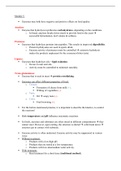Summary
Microbial Metabolism and Production Complete Summary
- Course
- Institution
Content covered includes: - Microbial metabolsim including respiration and fermentation as well as metabolic pathways - glutamic acid production - lysine production - citric acid production
[Show more]












